This is the third post in our series on architecture of Pakistan. Earlier we covered Merewether Tower, Karachi and Masjid Mahabat Khan, Peshawar in this series. Today we’ll take you to Sindh’s third largest city, Sukkur and to its one of the most significant landmarks, the minar-e-Masoomi (The Tower of Masoom)
The architecture of this tower is probably ungainly but there are few details that make it unique in Pakistan. The number 84 is significant with the architecture here as the tower is 84 ft (26 meters) high. One source claims the height of the minar as 31 meter. The number of steps to reach the top of the tower is 84. The circumference of the base of tower is also 84 feet.
The tower’s historical significance arises from the fact that it was built in 1605-1610 AD. In one of the references I read, the year of completion for the tower is given as 1607 A.D. Even with going with the conservative estimate of 1610 AD means the next year Tower of Masoom will complete 400 years of it existence.
It was built by Masoom Shah of Bukkur (an island on River Indus between Sukkur and Rohri). Masoom Shah was the Governer of the area in times of Mughal Emperor Akbar. The tower was built with the purpose of keeping a watch on the area.
On top of the tower is an observation balcony which is now covered with iron railing. At one time it became nototrious for suicidal people flinging themselves to death below. If you look carefully at the top of the tower in our title photo, you can see this iron railing on the viewing balcony. When was this iron cage built? I couldn’t research the date for sure but the last photo of this post below (circa 1896) shows this cage present, which means the iron cage was present atleast in the British era.
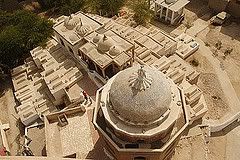 Next to the tower is a pavilion made of sandstone which has graves of Masoom Shah and his family. The sacrophagi are carved in the tradition of the Chaukundi tombs (near Thatta, Sindh). Photo to the left shows the view of these tombs from the top of the minar-e-Masoomi.
Next to the tower is a pavilion made of sandstone which has graves of Masoom Shah and his family. The sacrophagi are carved in the tradition of the Chaukundi tombs (near Thatta, Sindh). Photo to the left shows the view of these tombs from the top of the minar-e-Masoomi.
Following two photos show the stairwork and brickwork inside the tower.
Photo to the right below is from British library acrhive and it shows the tower of Masoom in 1896. Photographer was Henry Cousens.
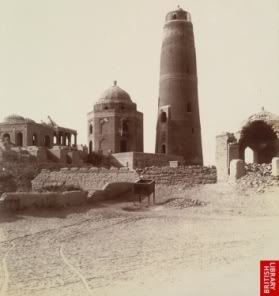
Cousens wrote in The Antiquities of Sind,
“The most conspicuous feature in the landscape is the tall minar of Mir Ma’sum…Its dropsical proportions, and uncertain undulating outline suggest putty or dough as the material of its construction rather than brick and mortar. Its lantern top, surrounded with an iron cage, make it look more like an antiquated lighthouse perambulating through the country…It rises to a height of about a hundred feet, is eighty-four feet in circumference at the base, and is somewhat out of the perpendicular…Under the shadow of the minar rest the remains of Mir Muhammad Ma’sum Shah, his father, and other members of his family, the Ma’sumi Sayyids…Over the graves are open canopies supported on square, flat and octagonal stone pillars whose shafts are covered with Persian writing in relief and other ornamental tracery…Between Mir Ma’sum’s grave and the base of the minaret is a domed octagonal building, apparently intended as a rest-house, which was built in A.H. 1004 (Plate LXXVIII) [this image]. It has four arched entrances, those on the east and west having a cut-stone ornamental balconied window above each of them. It is built of brick and is decorated with coloured tiles.”
Reference:
1. Insight Guide, Pakistan 2001
2. Steeped in history by Salman Rasheed
3. British Library, Online Gallery
4. Satellite Image of Masoom Shah’s minar
Photo Credits:
Clicking on the photos in the post above will take you their source web pages.
1. Mr. Agha Waseem
2. Mr. Kabir Khan
3. British Library Archives
ATP’s Other Posts on Architecture and Towers:
1. Merewether Tower, Karachi
2. Clock Towers of Pakistan
3. Masjid Mahabat Khan, Peshawar
4. Architecture in Pakistan: A historical Overview
5. Manora Lighthouse
6. Churches of Pakistan
7. Karachi Municipal Corporation Building
8. Architectural Heritage of Bahawalpur
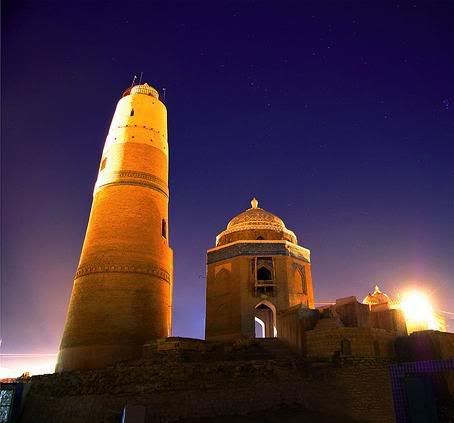
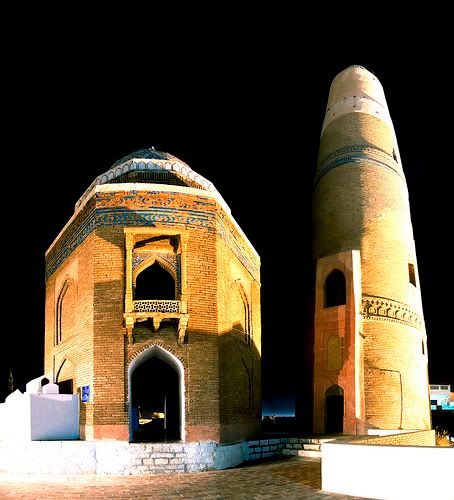
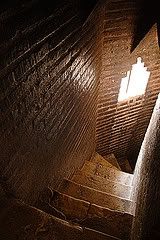
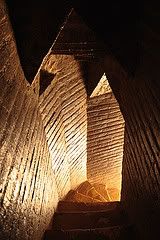



















































@………………….@………………………..
Latest (April 24, 2009) photos of meenar-e-masoomi appear at APP site today. see here, here and here.
I would like to congratulate u guys (Dr. Adil and Owais) for a very ‘cool’ stuff here. Patriotism, liveliness, way-forward urge and love for common pakistanis exude from not only the articles but also the comments; the comments r also informative and interesting.
Let me suggest u to include a sub-set which would be futuristic, educative and guiding towards a goal; a multi-dimensional learning encompassing important topics like how should various sections of society prepare themselves for the coming times which demand cut-throat efforts for all age groups.
The scope has to be broadened to integrate the efforts so as to give this country a hope to excel, which is totally amiss in this hohum.
1. The Qutb Minar is 72 meters high (237.8 ft) with 379 steps leading to the top. A tower in Delhi, India, it is the world’s tallest brick minaret.[2] Construction commenced in 1193 under the orders of India’s first Muslim ruler Qutb-ud-din Aibak, and the topmost storey of the minaret was completed in 1386 by Firuz Shah Tughluq.
2. The Dravidian Gopuram tower of the temple is 216 feet high and build around 1010.
3. Badshahi Mosque’s corner minars: 67′ in circumference, 176′-4″ high are in four stages and have a contained staircase with 204 steps. Built in 1673 by the Mughal Emperor Aurangzeb in Lahore, Pakistan.
4. Vijay Stambha is 37.19 meters high and has 157 narrow steps.
5. Minar-e-Masoomi, Sukkur at 31 meters.
6. Hiran Minar is set in peaceful environs near Lahore in Sheikhupura, Pakistan. It was constructed by Emperor Jehangir as a monument to Mansraj, one of his pet deers. It is 100-foot (30 m)-high minar. (The inside steps of Hiran Minar look simiar to the steps of Minar-e-Masoomi).
7. Wazir Khan Mosque’s two stately octagonal minars 100 feet in height and built starting around 1634-1635 A.D.
8. Kirti Stambh is 22 meters high, has 54 steps, built in 12th century.
Owais: We can not compare Masoomi Tower with those in Lahore. Towers in Lahore are built from red sandstone and white and gray limestone; materials of much higher compressive strength than the baked clay brick. Each has its own category. But nevertheless the Masoomi Tower and complex is a national treasure. I hope our people have the foresight to preserve it. It is my ignorance that I am learning about this 400 years old monument for the first time today. ATP must be credited for that.